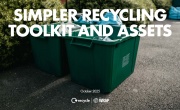UK households chuck 49 per cent of textiles in residual waste bin
New WRAP research reveals that each person in the UK throws an average of 35 items of unwanted textiles into general waste every year.
 The charity’s recently published Textiles Market Situation Report 2024 summarises the present state of the UK textiles market, providing data on consumption rates, clothing prices, imports and exports, manufacturing, post-consumer markets, and upcoming innovation.
The charity’s recently published Textiles Market Situation Report 2024 summarises the present state of the UK textiles market, providing data on consumption rates, clothing prices, imports and exports, manufacturing, post-consumer markets, and upcoming innovation.
The research documents how huge quantities of textiles are being discarded into residual black bins and general waste bays at Household Waste Recycling Centres (HWRCs).
According to WRAP, 49 per cent of unwanted clothing and textiles - or 711,000 tonnes (equivalent to 30,000 shipping containers) of fabric - are disposed of in this way.
Of the post-consumer textile waste thrown away in England in 2021, 84 per cent was incinerated in an energy-from-waste facility and 11 per cent was sent to landfill.
Highlighting how far the UK textiles industry is from achieving circularity, in 2022, the UK bought 1.42 million tonnes of textiles, whilst discarding just over the same quantity.
Harriet Lamb, CEO at WRAP, expressed her concern at the UK’s consumption and disposal habits: “We’re all buying too many new items and then putting too many clothes in the waste bin, consigning them to landfill or incineration.”
“These are valuable resources, not waste. We should be giving to charity shops who rely on the income, selling on e-commerce, repairing or sharing – anything but the bin!”
A struggling second-hand textiles market
Alongside more textiles being discarded into general waste streams, the quantity of post-consumer clothing entering the UK’s second-hand market is increasing.
WRAP warns that the UK’s textile reuse and recycling sector does not have sufficient infrastructure or labour to deal with the quantities of material it is now receiving. Charity shops, textile banks and processing centres are at maximum capacity.
At the same time, textile reuse and recycling organisations are making less money. This is largely because the high volume of cheap, low-quality fast fashion on the market is pushing down the prices of post-consumer textiles stock.
Effectively consumers are forced to ask themselves: ‘Why would I spend £10 on a second-hand T-shirt when I could get a new one from Primark for a fiver?’
WRAP data indicates that over the last ten years, prices per tonne of material have fallen by 58 per cent for textile banks (£406 in 2013 to £172.50 in 2023) and 41 per cent for charity shops (£432 in 2013 to £255 in 2023).
Building on concerns raised earlier this month, Alan Wheeler, CEO at the Textiles Recycling Association, said: “The quality of fashion is declining and the mass of textiles products put on the market is increasing.”
“We are also in a current situation where the global used textile industry is in a dire situation. Warehouses are full, collections are grinding to a halt, demand in the main global markets is being hugely disrupted, trade has dropped off a cliff, and news of layoffs and rumours of closures are a daily occurrence.”
Increased operational costs and socioeconomic shocks such as Brexit, Covid-19 and the cost-of-living crisis have further contributed to instability within the second-hand textiles industry. WRAP warns that ‘a perfect storm is brewing’.
What are the solutions?
WRAP is directing individuals to avoid throwing unwanted clothes and textiles in the bin and instead donate them through readily available collection avenues such as charity shops, textile banks, retailer take-back schemes and online marketplaces (e.g. eBay, Depop and Vinted).
Targeting the issue at the source by reducing consumption is also important. According to WRAP’s recent report, while consumption levels dropped during 2019 and 2020, they have now crept back up to pre-pandemic levels. In fact, the UK consumes more clothes per person than any other country in Europe.
Reflecting this, clothing brand Patagonia has this week released a 45-minute mocumentary - The Shitthropocene - which offers a ‘humorous’, ‘brutally honest’ and ‘thought-provoking’ exploration of consumption habits.
Additionally, WRAP highlights the need for system-level change and is urging brands, retailers, investors and governments to support the UK’s textile reuse and recycling sector through grants, investments and legislation.
Harriet Lamb emphasised the need to support the second-hand textiles industry: “The waste, recycling and reuse sectors are under immense pressure”, she said. “The UK is fortunate to have an existing infrastructure for textile collections that’s existed for generations.”
“To risk losing their knowledge and expertise would be a tragedy. We need action now so that we don’t let this vitally important sector crumble.”
On behalf of textiles recyclers, Wheeler agreed, commenting: “We need serious interventions and support from government and industry through policies such as EPR, product standards and minimum recycled content in new products.”
Brands could further support a circular fashion industry by designing clothes for durability and recyclability, WRAP says.
Another WRAP report - the Textiles Waste Hotspots Report - identifies key areas in the textiles lifecycle that should be targeted. For example, it notes that cotton and polyester are the most wasted fibres and that a large proportion of textile waste is generated during the processing state of production (when fibres are being spun into yarn).
Read WRAP’s full Textiles Market Situation Report 2024 here.










